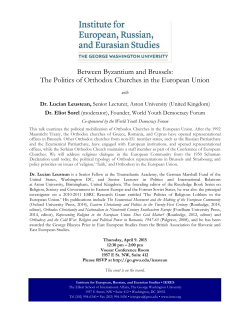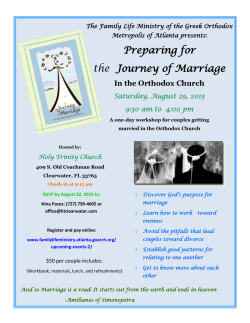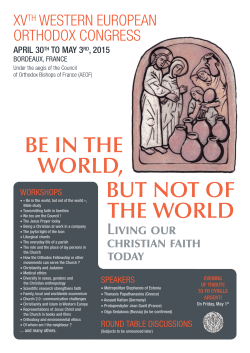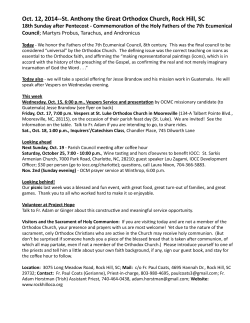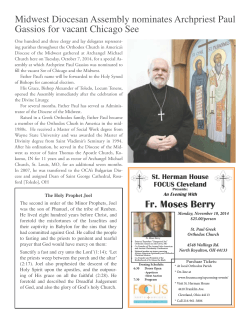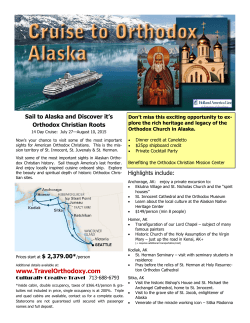
Orthodoxy and Modernity
The following article, an interview with His Grace, Bishop Ambrose, Director of Missions for the Holy Synod in Resistance, appeared in the religious periodical, Vatican Insider. Published under the aegis of the Italian daily La Stampa, its editors include such well-known American Roman Catholics as Mary Ann Glendon, the Harvard Law Professor and President of the Pontifical Institute of Social Sciences, and the philosopher and theologian Michael Novak. The article thus serves to bring our Synod’s witness and theological positions to the attention of a wider American and international audience. It was published on April 8, 2013, under the title “Ortodossia e Modernità.” The article and interview, conducted in Italian, can also be found on the periodical’s website in Spanish and English. We present here the somewhat stilted online English version, apparently based at least partly on a machine translation of the Italian original,* with slight revisions, approved by Bishop Ambrose, and sundry informational addenda. The text is otherwise faithful to the Vatican Insider’s version. Orthodoxy and Modernity Raffaele Guerra (for Vatican Insider) Rome On January 27, in the Serbian Orthodox Cathedral in Canberra, Bishop Ambrose (Baird) accepted official appointment as Bishop for those Serbian faithful of Australia and New Zealand who have been united, since 1961, under the aegis of the Free Serbian Orthodox Church. Bishop Ambrose is a member of the Holy Synod in Resistance of the Old Calendar Orthodox Church, serving in the Metropolis of Oropos and Phyle. It is the most dynamic, open, and moderate body among the traditionalist Greek Orthodox, who refused the imposition of the Gregorian Calendar by Constantinople on the Greek Church in 1924. He is an itinerant missionary bishop like few others: a polyglot who speaks eight languages and a theologian with numerous articles published in the USA and elsewhere, as well as the Director of Foreign Missions for his Synod,** which, aside from Greece, has churches in Italy, the United Kingdom, Sweden, the Czech Republic, Slovakia, Georgia, South Ossetia, Singapore, Malaysia, Kenya, Congo, Uganda, South Africa, the USA, Canada, Australia, and New Zealand. The Italian mission has two Dioceses: Nora-Cagliari, in Sardinia, under Bishop Michael, and Luni, in mainland Italy, under Bishop Silvano (Livi), which has been recognized by the State since 2004 and operates an Orthodox Theological Faculty in Pistoia and Rome. We met and interviewed Bishop Ambrose at the Monastery of St. Seraphim of Sarov in Pistoia. • A first question deals with your new position as Bishop in Australia. Why did the Free Serbian Orthodox Church of Australia decide to break communion with the Serbian Orthodox Patriarchate? In the past, the main reason for the separation between the Free Serbian Orthodox Church and Belgrade consisted in the fact that the Communist régime imposed itself on the Patriarchate. There were other reasons too; for example, the Serbs abroad were almost all monarchists. Moreover, the Titoist regime organized expansive libelous campaigns against the Serbs abroad. In 1961, the Serbs abroad separated themselves from the Patriarchate, and the Free Serbian Orthodox Church, which was established at that point, gathered the greater part of the faithful in the USA, Canada, and Australia. Dioceses were created, Bishops were consecrated, and churches and monasteries were built, such as the one in which I live in Australia. All of this was accomplished thanks to the money that Serbs abroad raised wholly on their own, without any help from the Patriarchate in Belgrade. In 1991, after the fall of the Communist régime, there was a reconciliation between the Free Serbian Orthodox Church and the Church of Serbia. It was, however, just a liturgical reconciliation: they established mutual communion, but without any form of administrative unification. Two years ago, Belgrade decided to unify the Australian Diocese of the Free Serbian Orthodox Church and the Patriarchal Diocese. This was not accepted by the faithful, partly because of some ecumenist actions of the Patriarchal bishop which were considered contrary to the Orthodox Faith. So, the Free Serbian communities, basing themselves on the legal statutes of the Free Serbian Orthodox Church of Australia, broke with the Serbian Patriarchate. They elected me as their new bishop last December, though without my previous consent. Nonetheless, this was undertaken according to the legal statutes of the Free Serbian Orthodox Church of Australia. Our Diocese has fourteen churches and a huge compound with a monastery, episcopal residence, a summer camp for children, a cemetery, a large conference room, and the largest Orthodox Cathedral in Australia. These churches are served by patriarchal clergy, and for the moment this will remain so; it is not for us to expel them. •How do you view your pastoral work among the Serbs of Australia? First of all, I think we must begin with substantial catechetical work. The faithful, in fact, have received no catechesis at all. I can count on each parish having a community school at its disposal where children learn the Serbian language and culture. This is fine, but we must introduce religious education as well. We will also start to use the English language for religious celebrations. In this way I hope to bring the church nearer to the younger faithful, who do not know their parents’ language as well. •Are there Orthodox converts in Australia? I have to say that the Orthodox churches using the English language are not many. This is a great obstacle to conversions. The Greek community is enormous: it has more than one million people, yet it was not very open to others, even considering its size. The second generation, however is not so, and the third is almost no longer Greek. We have gradually to change the attitudes of the Church, introducing, for example, the English language for religious celebrations. There have indeed been some Australian converts, but they are not many. We have a missionary monastic brotherhood in Melbourne that works with poor people in Serbia and Australia. They have also published some materials in English, and thanks to them some Australians have converted to Orthodoxy. However, this is a part of our mission which is not sufficiently developed. In Italy, on the other hand, you have an anomaly which is absent in Australia: the greater part of the Orthodox parishes celebrate in Catholic churches. How can you conduct a complete missionary endeavor when hospitality from the Holy See involves certain accords regulating that endeavor? By contrast, our own Synod’s mission in Italy not only owns its buildings, which are the property of our legal religious entity or corporation, but is recognized by the Italian State, and the two bishops, as well as the priests, are Italian. •In recent decades, your Synod has received various monastic and parish communities from other ecclesiastical ju- risdictions. This is the case, for instance, with regard to the historic monastery of the Russian Orthodox Church Outside Russia (ROCOR) in London. How do you account for these acquisitions? The ROCOR entities that asked to be received by the Synod in Resistance were two monasteries in England (the Brotherhood of St. Edward the Martyr and the Convent of the Annunciation), one in Canada, two St. Edward the Martyr Brotherhood, in Brookwood, England The Convent of the Annunciation, in London, England The Protection of the Holy Virgin Mary Convent, in Bluffton, Canada parishes in California, and part of a parish in New York that formed a new parish under our Synod. These entities came to us a little bit before the unification between the Russian Orthodox Church Outside Russia and the Moscow Patriarchate. Various institutions of the old ROCOR did not want to go under the Muscovite jurisdiction in 2007. They refused all of the privileges which could have come to them from the unification, and retreated to our Synod in Resistance or, alternatively, to our Sister Church under Metropolitan Agafangel, which continues the traditions of the old ROCOR, far from communion with Moscow. These entities would have accepted the unification only if the Moscow Patriarchate had withdrawn from the World Council of Churches, if it had renounced ecumenist politics, and if it had clearly condemned its past as a Soviet institution. These communities made, and still make, very notable sacrifices: a good many priests lost their homes, churches, and salaries, and they had to search for secular jobs to sustain their families, despite being priests. For the sake of the Orthodox Faith, they did not fear these sacrifices. The Church of the Holy Ascension, in Rochester, New York, The Church of St. Seraphim of Sarov and St. John of Kronstadt, in San Diego, CA •Today the state of Russian Orthodoxy is very alarming, both because of the relationship between the State and the Church and also because of the persecutions waged against the other Orthodox jurisdictions which find themselves in Russia. Last month a Russian male monastic brotherhood came to live in Italy, under bishop Silvano (Livi), who is at the head of your bigger ecclesiastical institution in Italy. Why did these monks leave Russia for Italy? At the outset, we have to say that the Moscow Patriarchate is a very complex phenomenon. In the first place, it is the second largest Church in the world, after the Catholic Church. The monastic brotherhood that has now arrived in Italy comes from the Republic of Mari El, in the Russian Federation, where there resides one of the few exemplary bishops of the Moscow Patriarchate. The monastery that these monks built in the place that was assigned to them was not habitable. In fact, they learned that it was on soil polluted with radioactive elements. They were forced to leave it. So, they took the initiative to leave the Muscovite jurisdiction too, which they had been unwillingly enduring for a long time. They knew that building a monastery in Russia outside the Muscovite jurisdiction was almost impossible. A peaceful monastic life would have been impossible. So, they came to Italy because they had known about our Synod for some time, and here they had a benefactor who wanted them to have a monastery. •You are also the director of your Synod’s missions in Africa, a continent with a significant Roman Catholic Church presence. Can you tell us something about your African missions? Do you have any relations with the Greek Patriarchate of Alexandria? Our relations with the Catholic Church in Africa have always been good and amiable; we have never had any sort of problem. In Kenya we have seven parishes, served by married priests, and a convent that is the first and only Orthodox convent in Black Africa. Nineteen nuns reside there, adher- The Convent of St. George, in Kenya ing to a traditional Orthodox way of life, as in a Greek monastery. In the Democratic Republic of Congo we have, by contrast, about a hundred parishes for a population of faithful numbering between forty and fifty thousand. There are only thirty-two priests, and they are engaged in a tremendous work, travelling on foot from one town to another in order to celebrate the Liturgy, baptize, and look after the spiritual lives of their parishioners. Our African clergy deserve immense respect; indeed, we cannot afford to give a salary to any of our priests. We can simply supply vestments and what is needed for the services, Mysteries, and instruction. We can provide nothing more. However, our mission is spiritually successful. The African people have entirely opened themselves to Orthodoxy. Another mission is just starting in the North of Congo, where I recently ordained four new priests. Moreover, we have begun publishing some books in their language. This entails linguistic experimentation in the realm of liturgics—it will take years before we will have the final versions of the texts. In Congo-Brazzaville (also known as the Republic of Congo), we have four priests, a school, and two parishes in the capital city. The Greek Orthodox Patriarchate of Alexandria has greater means in comparison to us. They can pay salaries to the priests and build schools, clinics, and beautiful churches. Almost all of our churches are, instead, made of mud bricks with roofs made of palm leaves. They also have the means to cause us some problems, such as preventing our clergy from acquiring visas to visit Greece, since the Patriarchate has tremendous influence over the Greek Embassy. We never had any problem, whether with Roman Catholics or with Anglicans, yet we have these problems with the Orthodox Patriarchate of Alexandria. •You are also the Locum Tenens of the State Church of South Ossetia, which is a borderland claimed both by Russia and Georgia in the ecclesiastical and political worlds. The peak of these conflicts was the poisoning of your predecessor in South Ossetia, some years ago. What is the situation of Orthodoxy in that land, given the grip of Moscow and Tbilisi? The international community considers South Ossetia part of Georgia, even though the coun- try proclaimed its independence in 1991, at the end of the Soviet dictatorship. We are dealing with a country that lived through more than twenty years of war with Georgia because of its struggle for independence. This situation brought about ethnic cleansing on both sides. The last conflict was in 2008, when South Ossetia was caught in the crossfire between Russia and Georgia on its own soil. The Orthodox churches of South Ossetia proclaimed their independence from the Georgian Patriarchate in 1991, but Moscow continued to consider the region a canonical territory of the Georgian Patriarchate. Tbilisi has also appointed a nominal bishop for South Ossetia, but he cannot go there, as the border is completely closed. In other words, without our Synod, the country would have been without a bishop and without clergy for more than twenty years, even up to this time. •How did your engagement with South Ossetia begin and how is it proceeding? In the beginning, the Russian Orthodox Church Outside Russia and the Ossetian State, together with the parishes of the country, turned to us, in order to place the situation in our hands. We took over the church there. We consecrated, as head of this Christian community, Bishop George (Pukhaev) of Alania, a young Russian monk with Ossetian origins. He literally reconstructed the Orthodox Christian Church in South Ossetia. After more than half a century of Soviet dictatorship, there was not a sole church left open in the entire area. Bishop George traversed the country to baptize and preach. When he opened the first church, there were just two women as faithful. Now we do not have sufficient space for all the faithful coming to the churches. In 2010, Bishop George was deliberately poisoned, subsequently retiring, despite his young age, because of the devastating damage to his health. He asked me to take his place. South Ossetia is a missionary area with a population not so much numerous as multiethnic: Ossetians (70%), Russians, Georgians, Greeks, Chechens, Armenians, Jews, Circassians, and Turks. Four of our churches are ancient Byzantine buildings, one dating from the 9th century, three from the 11th, and all in a disastrous state of preservation. The others date from the 16th to the present century. No one wants to restore the ancient churches, on account of the political situation. Indeed, I wrote to UNESCO for help, with no result. I also had an official conversation with the head of state, since these churches could be a real opportunity for tourism. In recent times, some money for restoration has arrived from Moscow, thanks to the interest of President Medvedev. As for Russia, Patriarch Kyrill admits that we are the sole Orthodox jurisdiction that can work in that area. He acknowledged thus to the South Ossetian ambassador in Moscow. •Your Synod, part of the diversity of Greek Orthodoxy, defines itself as being “in resistance.” This is a fundamental ecclesiological concept for you. What does it mean? The Orthodox Church is now passing through a period of ecclesiastical confusion. The spirit of ecumenism has entered into almost all the local Churches. The fundamental theological “device” of ecumenism is the “theology of baptism”; i.e., everyone who is baptized in the name of the Holy Trinity is fully Christian, and it does not matter if this was by a female or male priest, by aspersion or immersion, and so on. For us, all of this constitutes a problem. Our position is a traditional one: that ecumenism is a doctrinal heresy; thus, we broke communion with the Orthodox proponents of ecumenism. We do not consider them outside the Church—condemned: they are not so. We offer to all the Orthodox faithful who share our position a place where they can pray without any compromise with heresy. The theological concept of “resistance” was elaborated by St. Theodore the Studite in his heresiology. According to this spirit, we work together with the bodies that follow this path in Romania and Bulgaria, and with the remnant of the Russian Orthodox Church Outside Russia that did not unify itself with Moscow. Our position is not a fundamentalistic one. We are open to encounters, dialogue, and discussion with other Christian confessions and with other religions. The problem for us rests with the mutual acknowledgement and sharing of Mysteries. The Orthodox Church is enjoined to witness to the Orthodox Faith before other Christian confessions and other religions. •Can you say something about the present situation in Greece? I have just one thing to say: if it were not for the Orthodox churches in Greece, we would have many people starving to death. The Church is the only institution which engages in charitable work—as it should. But many charitable institutions of the Church have closed for lack of public funds. A great number of Greeks do not have a place to sleep or anything to eat. All of the parishes have become centers for the collection and distribution of basic necessities. Our Synod acts both through our main monastery in Phyle and through our women’s philanthropic organization to provide food, clothing, and necessities to the poor, including non-Orthodox immigrants and prisoners. Greece is passing through a very difficult period in its history. Those who can go away—that is, the most qualified—leave for the United States, Europe, and Australia. Youth unemployment has exceeded 50%, and the number of marriages has understandably dropped. • There is another burning issue for Greece: a judgment of the European Court of Human Rights has already requested the Greek State to bring about an effective separation from the Church. If Greece is to remain in the EU, it will have to proceed on this path. How would the landscape of Greek Orthodoxy change if that happened? In 1924, Greece was required to accommodate a million and a half refugees from Asia Minor. Keep in mind that, at that time, the entire population of Greece hovered only around three million inhabitants. At the time, the Church made a deal with the State, giving about 95% of its property for the accommodation of the refugees. In return, the State agreed to pay the wages of the clergy. The State (New Calendar) Church of Greece now says that it is ready to accept a separation of Church and State, but it asks back its properties. Without any income it cannot go ahead. The State, however, cannot engage in this return. To date, between the Church and the State there is a new deal: for every five priests who retire or die, the State will pay the salary of just one new priest. It is clear, therefore, that the clergy have diminished in recent times. The State Church of Greece has begun to ordain priests without a salary, as is the case with all the clergy of the Churches in resistance (the Old Calendarists). These priests are persons who have a salary from their secular employment. We have never received a penny from the Greek State, and because of that the State has developed great respect for us. We have built churches and done everything else in complete freedom, as a result. * The original Italian-language interview with His Grace can be found on the website of the “Vatican Insider” at http://vaticaninsider.lastampa.it/documenti/dettaglio-articolo/articolo/australia-ortodossia-orthodoxyothodoxia-23904/ ** His Grace, Bishop Ambrose undertook his undergraduate and graduate schooling at the University of London, the latter at the prestigious Courtauld Institute of Art. His family counts among its distinguished members such figures, on his paternal side, as John Macwhirter, the Scottish landscape painter, and, on his maternal side, Sir Moses Montefiore, the famous English banker and philanthropist. Montefiore’s nephew, Arthur Cohen, King’s Counsel, was a Member of Parliament, Standing Counsel for Cambridge University (his alma mater), Vice-President of the London School of Jewish Studies, a Judge of the Cinque Ports, and Bishop Ambrose’s great-grandfather.
© Copyright 2025
